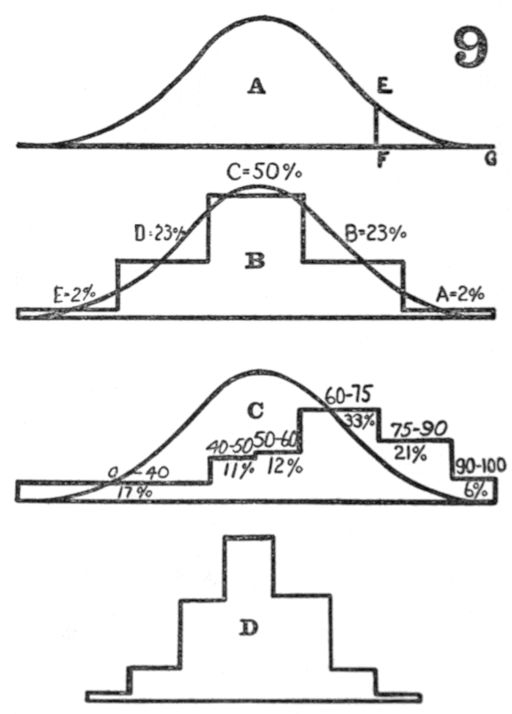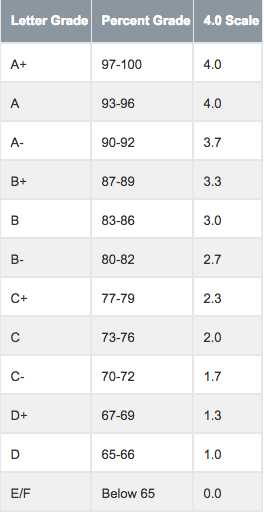If you’ve ever felt uncertain about a final grade, even after receiving the raw scores on all your assignments, you’ve come to the right place. Grading and curving can feel more confusing than angular momentum. Who doesn’t feel frustrated waiting week after week for a single letter that decides your GPA? That’s why we took your questions straight to the source of all things grade-related.
Check out the methods used by the ultimate grade calculators, AKA professors.
How to get a good grade

Professors are not your enemy (I know, shocking). Curves are meant to help you. Your professors’ main goal in grading is to get an accurate sense of how much effort the students have put into the class and how well they know the material compared to their classmates. Through this evaluative process, they want to reward the students who excel in both. In other words? Spend active brain time in lecture and do your homework.
The Caveat
Before you get too far, keep this in mind. Can professors really measure students’ competence correctly and fairly? Not always. That’s why professors have different grading methods for different classes and adjust their grading strategies over time. Don’t be surprised if everyone in your intro to singing class gets a B+ or if 70 percent of your chem class gets a C. It may feel annoying when professors say they don’t know what the curve will be like, but trust that whatever adjustments they make are done with the intention of being fair.
Initial screening methods

Your instructor usually looks through all the exams or papers before grading begins. “I instruct the TAs to look at many exams before they begin to actually grade them to get a feel of how students are doing and then adjust accordingly, meaning that if everybody is missing a concept, then the penalty for missing it will be reduced overall,” said University of California, Los Angeles Communication Studies Professor Greg Bryant. This initial screening gives the instructor a general sense of what the students struggled with as a whole. If everyone missed a question, it’s likely the professor didn’t explain the concept thoroughly enough in class, so it wouldn’t be fair to penalize everyone for that. “This is a form of a curve that is built into the grading process, so I don’t curve after that,” Bryant said.
And even though your TA usually does the grading, don’t think that your professor stays clueless about how well you’re doing. Many professors will at least read through all the exams if they don’t at least grade part of them.
Curving methods

Still confused? You’re not alone. Even professors remain a little bewildered about this concept. “What’s a curve?” asked UCLA physics department professor Brent Corbin. “Actually, I’m sort of serious. I know what folks mean when they use the expression and how they use it, but I’m not convinced that it is much more than a convenience for the grader.” Several of the professors we polled actually seem to share his attitude regarding curves. Professors believe in gauging students’ mastery of the material relative to the other people in the class, so they just come up with what they think works best.
The best way to beat the curve lies in outdoing your classmates. That said, here is a common curving practice:
- Calculate the weighted average of students’ raw final scores
- Take that into consideration and compare it to students’ scores from previous terms
- Group students into grades with an eye on how the class scores as a whole
Some professors even review assignments or exams after calculating an average (or other kind of benchmark) to see whether the students’ mistakes stem from not grasping the concepts or misreading the questions. If the majority of students got a question wrong, it’s likely that the concept was not explained well in class, or the question was phrased in an unfair, confusing way. If either of these situations appear to be the case, the professor might even discount those questions.
Get to know your professors

In general, curves are flexible. Professors care more about how much the students have learned. “I try to get to know as many students as I can over the term, to know their strengths, weaknesses and get a sense of where they sit on [my] rubric,” said Professor Corbin. The takeaway? Make sure to show your professor your competency with the same energy you do when scouring the web for grade calculators.
If you feel unsettled after that tough English midterm but have convinced your professor during office hours that you have mastered the course, he/she understands you might just have testing anxiety. “For students I don’t know well, I have to rely more on that final weighted score—but it’s not so terribly difficult to place them in one group or another by comparing their performance to that of the students I know,” Professor Corbin said. If you want the benefit of doubt, go to your professor’s next office hours.
A TA’s role

Your TAs’ influence on grading mostly depends on how well they know their students. “If the TA has really connected with the students, I may give them the opportunity to advocate for students I may have misjudged,” said Professor Corbin. For certain courses, specifically in the humanities and social sciences, TAs naturally have more interaction with students because students are encouraged to go to their office hours for their papers.
As an English and communication studies double major, I can tell you that most—if not all—of my TAs make it clear that grading and curving methods come out of discussions with the professors. “They are the ones who judge how well students are getting the answer I expect, so they have a fairly substantial role,” Professor Bryant said.
On the other hand, a professor may not consult too much with the TAs on grades if the TAs don’t know much more about the students than the professor. In either case, it’s always a good idea to get to know your TAs.
The Golden 12-Level Scale

This method doesn’t have an official name, but we’ve heard professors refer to it as the 12-level scale. The 12-level scale is a very common grading method that theoretically allows pretty even grade distribution. Not counting the F grade, which is 59 percent or lower, you have 12 levels of grades ranging from the dreaded D- to the brag-worthy A+. Each letter grade (plus/minus sign included) then gets a equal percentage of distribution: D- 60-62, D 63-66, D+ 67-69, C- 70-72, C 73-76, C+ 77-79, B- 80-82, B 83-86, B+ 87-89, A- 90-92, A 93-96, A+ 97-100.
If you have a course that doesn’t use a scale/curve, then the 12-level scale is very likely how points, after they’re converted to percentages of the total points, are turned into letter grades. This method works best if the class counts points, so you’ll more likely see science professors use the 12-level scale, if they choose not to curve. The plus side of not setting a curve? Everyone has a chance to get an A. However, if the class screws up big time, potentially everyone can fail as well. Also, keep in mind that although the 12-level scale is more straightforward, it doesn’t give you that extra push to outdo others your class.
How Most Liberal Arts Classes Work

What about liberal arts classes? They don’t count points but don’t have curves either. Remember how Professor Bryant said his curves are built into the individual exam grades? Liberal arts classes that just spit out letter grades for each and every one of your assignments work in a similar way. However, this does not mean that liberal arts professors don’t count points when they’re grading your papers or exams. They likely have rubrics that outline how many points your thesis and your organization are worth and another table that converts total points into grades, but you’ll only get to see a single letter instead of the nitty-gritty numbers.
Don’t worry, you can still get a good idea of what your grade is without one of those nifty tables. Here’s a pretty universal table that converts between letters and numbers for grades.

When in doubt…ask!
If you don’t see the grading details on the syllabus, raise your hand and say something. If your professor’s answer is vague, or you’re just too intimidated, try asking your TA. Everyone will thank you for it.
The Grand Finale: A GPA Calculator
Wondering how to calculate your GPA before sending your transcripts to grad schools? Here’s a final bonus for those who trust their computers more when it comes to math. This GPA calculator will calculate your weighted average. Take course A, multiply its credit hours with the grade earned, and divide it by the total credit hours of that semester/quarter. Then, do the same for the rest of your courses. Voila, you’ve got your final GPA for that semester/quarter. Satisfied? Keep it up next semester.
*Updated May 30, 2017 by Bonnie Ni to include the GPA calculator widget and its corresponding paragraph.



















